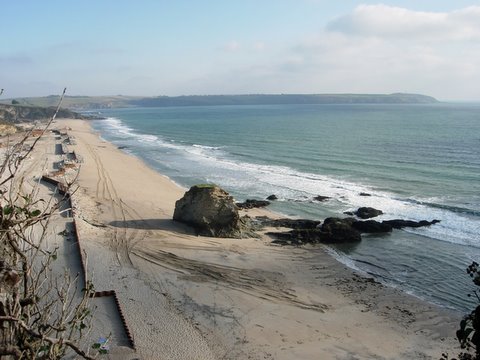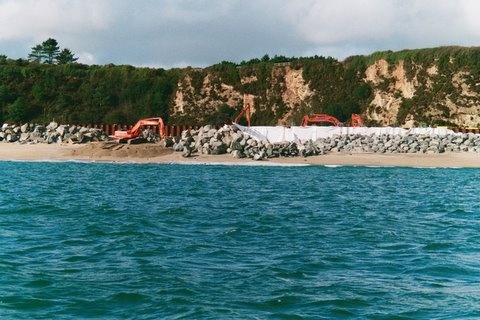





|
|
|
|
|
|

 |
 |
||||||||||||||||
|
|
|||||||||||||||||
|
|
||||
 |
| Carlyon Bay at low tide showing the line of shuttering |
A five-week public inquiry was held between 7 November and 8 December 2006 after a prolonged campaign by Carlyon Bay Watch and objections to the sea defence scheme from Cornwall County Council and the Environment Agency. Following the Inquiry Inspector's recommendation, planning permission for the placement of beach replenishment material and the provision of a revised design of sea wall at Crinnis, Shorthorn and Polgaver beaches, Carlyon Bay was refused by the Secretary of State for Communities and Local Government.
That refusal was challenged by Ampersand in the High Court but after a number of deferrals it was overtaken by their decision to submit a new application.
SECRETARY OF STATE'S DECISION
The Secretary of State's decision was that the proposal "conflicts with the relevant development plan policies. She has gone on to consider whether there are material considerations of sufficient weight to overcome this conflict. She concludes that ... the development .... would conflict with PPS1, PPG13 and PPG20. She considers that the existence of an extant permission is a fallback position that represents a material consideration in determining this application. However, she does not consider that the material considerations put forward are of sufficent weight to determine this application other than in accordance with the development plan.
"Accordingly, for the reasons given above, the Secretary of State agrees with the Inspector's recommendation. She hereby refuses planning permission for ... the placement of beach replenishment material and the provision of a revised design of sea wall on Crinnis, Shorthorn and Polgaver beaches, Carlyon Bay".
GOVERNMENT POLICY

Boulders dumped on the beach as part of sea defences
PPS1 (Planning Policy Statement 1)
This sets out the principle of sustainable development as meeting the needs of the present without compromising the ability of future generations to meet their own needs. It identifies the four aims as social progress, environmental protection, prudent use of natural resources and economic growth and employment.
The Inspector's report said: "Having considered these matters, I conclude that the application proposals are generally unsustainable." He went on to explain that the scheme "would provide the necessary standard of flood protection, but in this largely undeveloped coastal situation, may only be justified if the holiday complex itself is to be developed. At the same time, it would cause some harm to highway amenity and safety considerations and would be generally unsustainable."
PPG13 (Planning Policy Guidance 13)
This promotes highway safety and sustainable transport for people and freight.
The Inspector concluded that "even allowing for the proposed mitigation measures, there would still be some material harm to amenity and probably to highway safety considerations. Additionally, the proposed scheme would entail a considerable number of HGV movements which national policy would seek to reduce, unless outweighed by other considerations."
PPG20 (Planning Policy Guidance 20)
This seeks to direct developments away from the undeveloped coastline.
The Inspector concluded "this would be a large engineered development in a largely undeveloped bay."
CBW'S CASE FOR A PUBLIC INQUIRY
Carlyon Bay Watch has consistently promoted the case for an environmentally friendly redevelopment of the existing brownfield site at Crinnis, but is opposed to the development on the beach on this overwhelming and environmentally damaging scale.
We believe that there are many uncertainties associated with the modelling used to predict the behaviour of the beach and a lack of long term data. Given these uncertainties we believe the evidence of local people about the beach's behaviour is particularly important. CBW members are concerned because of the unique nature of the material which makes up the beach, its stability and its suitability for any development not attached to bedrock.
The proposed sea defence scheme would lead to a significant increase in construction traffic compared to the 1990 scheme - 32 tonne HGVs 100 times a day while the extra beach material is being brought in. Further replenishment would also be necessary in the future. Given our concerns about the uncertainties involved in the modelling used to predict amounts of recharge required and the potential need to respond quickly after a storm, the scheme has implications for long-term sustainability because it commits future generations to transporting recharge material to the site.
Once the material is placed on the beach future generations are essentially being subjected to an experiment and are committed to finding ways to ensure that enough recharge is kept in front of the proposed wall to allow it to do its job. Recycling from one end of the beach to the other as sand is swept east by the waves may need to be done regularly and urgently during a long period of severe weather.
The proposed wall was contrary to the local development plan and policy and would cause more "harm" in terms of its effects on the environment and traffic congestion which was not outweighed by any "benefits".
It was and still is Carlyon Bay Watch's view that large-scale residential development on this beach will create a serious risk to human life. Building such a development at virtually sea level, backed by a sheer cliff, with a single access road, seems to fly in the face of all current policy and international thinking. If all 500 dwellings are occupied, an emergency evacuation could see up to 2,000 people being led to safety - including children, the elderly and disabled. How will they get out and up the access road (as emergency services are perhaps trying to get in) and where will they go when rescued?
(Read in detail the reasons why experts agree with Carlyon Bay Watch that this development should never be built. Alan Francis, retired Chief Production Geologist for English China Clays told the Inspector that the beach was highly mobile and claimed that the flaws and negative aspects of the proposed development remain unanswered. This is an experimental development, he said. John Woods, the former Chief Engineer in charge of Cornwall's flood defences for the National Rivers Authority has always been opposed to any residential development on the beach and believes it could be disastrous in the event of a severe storm.)
For general enquiries email Carlyonbaywatch@aol.com
